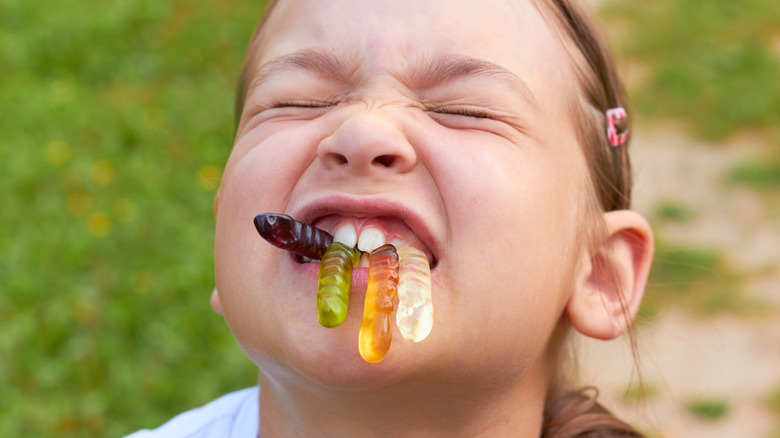Everything You Wanted To Know About Cavities
According to the Centers for Disease Control and Prevention (CDC), 90% of adults over the age of 20 have had at least one cavity. If you're one of the 10% who has never experienced having or filling a cavity, consider yourself lucky. For the rest of us, cavities, also called dental caries, can cause pain, tooth decay, and tooth loss. And if you've ever experienced the pain caused by a cavity, you know it can drive you absolutely bonkers.
Cavities are nothing new. The Super Dentists say some of the earliest cavities have been found in human fossils as old as 4.4 million years, about 1 million years before the Paleolithic period. But cavities weren't always as common as they are today. In fact, some sources say early humans had fewer cavities than modern humans, even though dental care is far superior today. Why?
Here's everything you wanted to know about cavities.
Beware the infernal torments of the tooth worm
Various solutions and treatments for cavities are thought to have been used throughout the years, beginning in the Mesolithic period, around 7,000 B.C. in Pakistan. A 2015 study in Nature discusses evidence of cavity treatment in a 14,000-year-old molar found in the skeleton of a 25-year-old man. The tooth had signs that the enamel was chipped away with flint tools in multiple attempts to dig out a cavity.
Many other ancient cultures treated cavities in various other ways. A 2009 study in Orvostort Kozlemenyek claims Egyptians inserted substances like garlic, incense, or seeds into the cavity hole. Romans and Greeks filled cavities with lead or wood, and the ancient Chinese filled holes with silver paste.
But even after cavity treatments started, people didn't know why or how cavities occurred. Early cultures thought cavities were caused by a tooth worm, beginning in Mesopotamia around 1800 B.C. (per UT Health San Antonio School of Dentistry). Yes, that's right, people apparently believed there was an actual worm that entered the tooth and made holes like a worm makes holes in an apple.
Fauchard discovers cavities come from sugar
The tooth worm mythos persisted until pioneering surgical dentist Pierre Fauchard denounced the theory in 1728 (via History of Dentistry). Fauchard, considered the father of modern dentistry, was the first dentist to pinpoint sugar and tartaric acid and sugar as the ultimate cavity culprit. He was the first dentist to recommend filling cavity holes with amalgams, which were lead, tin, or gold at the time. Fauchard also called out fraudulent practices used by some dentists at the time, such as fake fillings and using harmful nitric and sulfuric acids to remove tartar.
So, where do cavities actually come from, and is there really any way to prevent them? Evidence from Paleolithic skeletons shows Fauchard was right. The Super Dentists explain that cavities became more common after humans transitioned from a meat-dependent Paleo diet to plant-based agricultural diets. Early plant-based diets heavily relied on grains, like wheat or rice. And, according to Education.com, saliva converts these starchy grains to glucose when we chew.
Cavities are the leading chronic disease in adults and children
If teeth are not cleaned properly, these sugary starches can stick to teeth and lead to cavities. Pasha Dental warns that bacteria called Streptococcus mutans can feed off the residue from the food and drinks you consume. These bacteria excrete an acid that wears down tooth enamel and causes cavities to form.
But the food you eat and how often or well you clean your teeth are not the only factors that can make you more prone to cavities. Everyone has mouth bacteria, but some people have more bacteria inside the mouth than others. More bacteria means more acid, and more acid ups the risk of cavities.
Bacteria, saliva, and food residue combine to form plaque and coat the teeth, opening the door for cavities to form. Cavity and plaque-forming bacteria love starchy carbs and sugary foods, and the average modern Western diet contains lots of both. Our carb and sugar-packed diets could be why the National Institute of Dental and Craniofacial Research (NIDCR) says cavities are the number one chronic disease in children and adults, even though they are preventable.
Cavities occur in five stages before tooth loss
Five stages of cavity formation can occur before tooth loss becomes inevitable.
It starts with surface damage to tooth enamel, the thin protective surface that coats the teeth (per Humana). Enamel is clear, and the actual tooth color is seen in the dentin, the layer beneath the enamel. As you age, the enamel breaks down, and teeth show more dentin, giving them a yellowish appearance. Erosion can also cause chips and cracks in the enamel, providing tiny pockets for bacteria and acid to hide. According to Pasha Dental, stage one cavities appear as white spots on the enamel.
Stage two cavities cause enamel to erode further and form incipient lesions.
Stage three cavities begin to invade the dentin layer. This is when people start to feel pain or discomfort and typically visit a dentist. Stage three cavities usually require drilling and filling to mend.
A stage four hole goes down into the pulp, or nerve, of the tooth. This is the innermost portion of the tooth, and once it is infected with bacteria with bacteria, the cavity can be mind-numbingly painful. Stage four requires a root canal and crown.
Stage five infects the roots, causing a dangerous abscess. Left untreated, the infection can spread to the jaw, throat, or brain and potentially turn deadly (via Healthline). The tooth could possibly still be saved at stage five with oral surgery (per Pasha Dental).
Brushing, flossing, and eating healthy can help prevent cavities
As mentioned, tooth decay is the leading chronic disease in the U.S., but it is preventable. Making some simple changes to your daily routine could help you and your family keep cavities from cropping up before they cause a problem.
Pasha Dental recommends brushing twice a day and flossing every night. Why? Saliva helps wash away acids and keep them from building up during the day, and drinking water also helps flush them out. But at night, your mouth doesn't make saliva, and you're probably not drinking much water, so acids can build up and go to town on your teeth. Brushing with toothpaste or tooth powder and flossing remove much of the bacteria and food or drink residue built up throughout the day and reduces the amount of acid left in your mouth.
Cavity-causing bacteria live for junk food, so eating healthier can help protect your oral health, too. Historians have found that past civilizations, like the Romans in Pompeii, had nearly perfect teeth. Orthodontist Elisa Vanacore credits a diet low in sugar and high in fruits and vegetables with the people's incredibly healthy teeth, saying, "They ate better than we did and have really good teeth" (via Quartz).
The American Dental Association recommends visiting your dentist once or twice per year for professional cleanings and exams to prevent problems from occurring in the first place.






